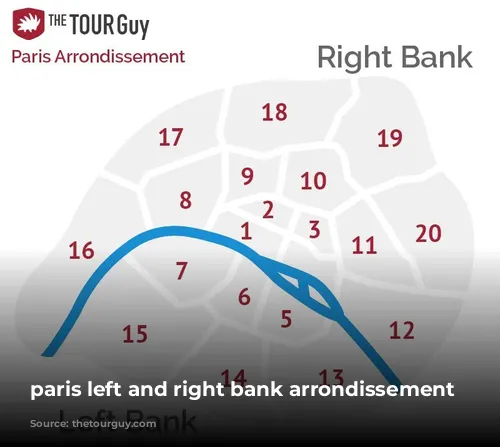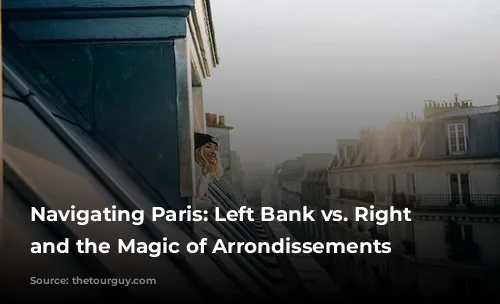Stepping into the City of Lights can be a little overwhelming, especially when you hear locals casually tossing around phrases like “Meet me in the 4th” or “I’m staying on the left bank, the right is too posh for me.” Don’t worry, we’re here to break down the magic behind Paris’ geography and help you become a true Parisian in no time.
This article will shed light on the fascinating difference between the Left Bank and Right Bank, along with a quick rundown of the famed Parisian “arrondissements.” It’s like having a secret map that unlocks the hidden treasures of this enchanting city.

Understanding the “Banks” of Paris: A Quick Guide
Picture this: You’re standing on the banks of the Seine, facing the ocean. The Right Bank (also known as the Rive Droite) is the side of the river that lies to your right. On the other side, where your left hand would point, you’ll find the Left Bank (or Rive Gauche).
Paris is also organized into 20 districts, known as arrondissements. These are numbered in a clockwise spiral starting from the Louvre and Tuileries Gardens, which are located in the heart of Paris. The central arrondissements are smaller and become larger as you move further out from the city center.
So, in a nutshell, that’s the basic geography of Paris. But there’s more to this story than just a simple division by the Seine. The Left Bank and Right Bank hold a rich history, filled with distinct personalities and cultural quirks. Let’s dive into the fascinating details.
What’s in a Name? Unveiling the Secret History of Paris’ Arrondissements
To truly appreciate the unique charm of Paris, you need to understand the significance of the arrondissements. It’s not just about numbers; it’s about stories. Let’s journey back in time to unravel the secrets behind these Parisian districts:
In 1795, Paris was divided into 12 arrondissements. The first nine nestled on the Right Bank, while the remaining three occupied the Left Bank. This initial division laid the groundwork for the city’s future growth.
Then, during the mid-19th century, Napoleon III, with a vision to expand the city, introduced a new layout, increasing the number of arrondissements to 20. This significant change, enacted in 1860, reshaped the urban landscape of Paris, creating the city we know today.
One hilarious detail from this expansion involves the residents of a neighborhood called Passy. Initially part of the 1st arrondissement, Passy found itself unexpectedly relocated to the 13th. This didn’t sit well with the residents, especially since the 13th was known for having a somewhat less glamorous reputation.
The residents of Passy were adamant about their status, and they managed to get the layout revised, ultimately landing in the 16th arrondissement. This anecdote perfectly captures the sense of identity and pride that each arrondissement holds for its residents.
Don’t feel overwhelmed by the word “arrondissement.” Locals typically just say “the 5th” instead of “the 5th arrondissement.” You can also find the shortened “arr.” used in literature. So, if you want to sound like a Parisian, just say “the 5th” when referring to the Latin Quarter.
The Right Bank: Where History Meets Glamour
Historically, the Right Bank has been the heart of Paris’ commercial scene, a hub for industry and wealth. It was the home of the “industrious” or the city’s affluent upper class, who built their fortunes and established their presence in this vibrant district.
This side of the Seine is also home to some of Paris’ most iconic museums, including the Louvre, the Musée d’Art Moderne, and the Musée de l’Orangerie. These architectural gems serve as a testament to the Right Bank’s enduring influence on the cultural landscape of Paris.
The Right Bank’s allure extends beyond museums and galleries; it’s also renowned for its chic boutiques, upscale restaurants, and buzzing bars. This area attracts the discerning traveler who appreciates the finer things in life.
The Left Bank: The Bohemian Spirit of Creativity and Innovation
The Left Bank, on the other hand, has long been associated with Paris’ bohemian spirit. This creative energy emanated from the presence of universities like the Sorbonne and the Latin Quarter (5th and 6th arrondissements).
The affordability of housing in these districts attracted students and artists seeking a haven for their creative pursuits. The Left Bank was a melting pot of ideas and a fertile ground for the artistic movements that shaped modern art.
The iconic Shakespeare and Company bookstore, founded by American Sylvia Beach in 1919, further cemented the Left Bank’s reputation as a haven for writers and intellectuals. This haven for literary enthusiasts drew in renowned authors like Ernest Hemingway, F. Scott Fitzgerald, and James Joyce.
While both sides of the Seine have evolved, the Left Bank still retains its artistic charm. However, today, the boundaries between the two banks have blurred, and both areas have embraced the luxury and sophistication that has become synonymous with Paris.

Embracing the Parisian Spirit: Choosing Your Parisian Adventure
Ultimately, the choice of staying on the Left Bank or Right Bank is a personal one, influenced by your preferences and travel style.
If you crave the vibrant cultural scene of museums, fashion, and fine dining, the Right Bank might be your perfect fit. But if you yearn for the artistic energy of student life, cozy cafes, and charming bookstores, then the Left Bank beckons.
And remember, the magic of Paris isn’t confined to any single arrondissement. The City of Lights invites you to explore its every corner, to discover hidden gems, and to embrace the unique charm that each neighborhood offers. So, don your walking shoes, wander through the streets, and let Paris weave its magic around you.





